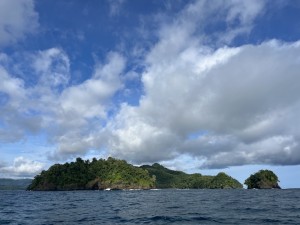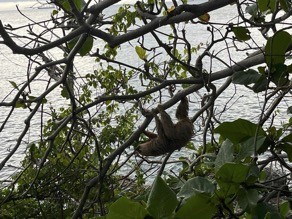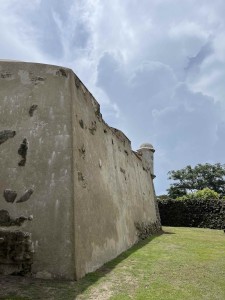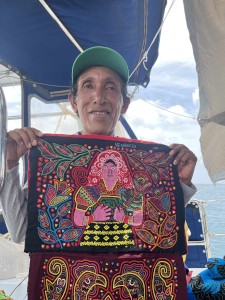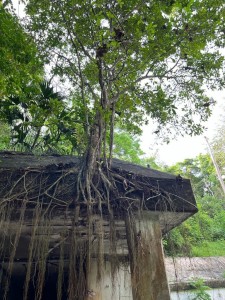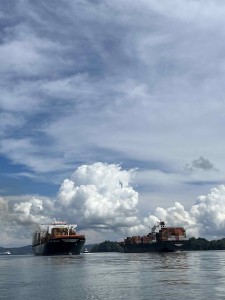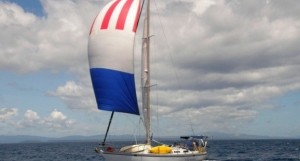Tokimata's Travels
| Vessel Name: | Tokimata |
| Vessel Make/Model: | Ganley S130 steel cutter |
| Hailing Port: | Coromandel, New Zealand |
| Crew: | Peter, Rachel, Danny and Tom Garden |
06 September 2023 | Bahia Nonda
Panama Pacific Coast
It’s now well over a month since we left Panama City. La Brisas the free anchorage on the long causeway joining three islands, was free but not the greatest pace to stay, with poor holding and many disintegrating boats, but this amazing backdrop of skyscrapers behind. These free places where yachts [...]
07 August 2023
Panama City
We fuelled up on 20th July 2023 and filled with water, ready for the passage through the Panama Canal. We were to leave around 2 pm next day, staying overnight in Gatun lake with our local line-handlers, and should be through by 3 pm on the following day.
21 July 2023
Rio Chagres and Portabelo on the Caribbean coast of Panama.
We left the San Blas islands on July 10 2023, after a last visit to Ivin, the wonderful chef at Hollandais Cays. He gave a few more image files for his recipe book and we bought his terrific coconut cake one last time. At 11.30 we upped anchor and were off on our way back east, the transit through the [...]
13 July 2023
The islands of San Blas
On Friday 23rd June at last we headed across the busy canal entrance from Shelter Bay marina and into the Caribbean sea. We were sailing to the San Blas islands, Kuna Yala to the inhabitants, hundreds of small islands and coastal villages that are still administered by the indigenous owners of the land. [...]
30 June 2023
The jungles of Panama
Grinding rust on the hull of Tokimata eventually gave way to grinding rust on the decks, but this was made much easier by hiring energetic boatyard workers. Eventually this progressed to painting, using two part polyurethane over the various anti-rust treatments and primers they had applied. However [...]
07 June 2023
Two weeks in Panama
We arrived in Panama City Tuesday 23rd May from Manchester, with our usual heavy luggage: this time a Starlink system was the bulk of it along with other boat essentials. After travel via Amsterdam we arrived at last to see our taxi-driver holding a “Mr Peter” sign and were off for the hour and a [...]
Tuktoyaktuk to Cambridge Bay
The first night out of Tuk was quite squally with 25kt gusts and rain then it settled down to 15 knot north westerlies and 2 days of easy running under spinnaker. We passed the famous Tuk pingos - almost pyramid like mounds up to 30 metres high thrust out of the flat ground by a curious action of small lakes freezing and thawing and driving the permafrost upwards. These exist underwater also and account for some very uneven sea bed off the MacKenzie delta.
We saw our first bowhead whales - the species of large wales (up to 25 metres) almost hunted to extinction by the whalers in the early 1900's. They could get up to 10,000 gallons of oil from a single whale, as well as baleen for woman's corsets. Fortunately the substitution of wale oil by mineral oils, and changing fashions saved the last few bowheads and population has rebounded slowly. There is is still subsistence hunting in both Canada and Alaska with a quote set for each village of a handful of "strikes" per year. A strike means an attack on a whale - so if they miss catching it they have used up a strike. This seems to be an effective measure for reduce waste and ensuring a clean kill. A few dozen whales may be caught each season across the arctic by subsistence hunters. We had a sample of muktuk - the outer blubber and skin of a bowhead whale in Nome.
We passed Cape Bathurst and Cape Parry - Bathhurst with its famous "smoking hills" where underground coal and peat has been burning for centuries and emits smoke from the hills. It was not visible to us as we were too far out. Cape Parry has a good harbour but we wanted to push on while the wind was good and made out way across Amundsen Gulf and into Coronation Gulf and along the south shore of Victoria Island. We spotted enticing looking Johansen Bay on the chart and decided to haul in there on 15th August at about 8pm. It is a large bay which has barely been surveyed except for a few lines of soundings running in that were obviously taken by single ships going in or out. We went into the northeast corner of the bay and anchored in front of a group of 4 muskoxen grazing on the shore under a big bluff with a prominent cairn on top. On the far side of the bay were what like looked like the ruins of a couple of cabins. Well out to our west we could see a long steep road coming down from another bluff to what looked like a landing place about 3 or 4 miles along the bay. That night we had my birthday dinner complete with chocolate self saucing pudding made in the bread maker - yummy.
The next morning we set off in the dinghy to explore the lagoon and shoreline to the east. We found two more sets of old cabins - one abandoned and one that seemed to be an active fish camp with an electric fence round the huts to keep animals out driven by a small wind turbine. Tom and Dan set off with the fishing gear to some small lakes up the substantial river and Rachel and I wandered over the tundra where we came across a family group of Caribou, a group of male muskox, canada geese nesting and loads and loads of bones. The tundra seemed to be littered with the remains of dead caribou, muskox and we even found a bear skull and a wolverine skull. Apparently in recent years grizzlies have started coming over to Victoria Island from the mainland so we could not tell if the skull was from one of them or a polar bear. No one is quite sure what the grizzlies live on on Victoria Island as the arctic char in the rivers are much harder to catch than salmon, and one of their staples - squirrels - does not seem to be present on the island. Even the caribou are seasonal visitors. They come for the summer - crossing from the mainland on the last of the winter ice that covers the 50 miles wide Coronation Gulf and then going back in the autumn when new ice has formed.
The old huts were derelict with the remains of hunting and domestic life visible - loads of oil drums, an old rifle hanging on the wall, lines of traps dangling, a sewing machine, a child's rocking horse, several abandoned snow machines and loads of old pistons and engine bits form outboards and snow machine engines. By the look of the number of dead snow mobiles it looked like these camps were winter hunting stops as well as summer fish camps. Only the huts surrounded by the electric fence seem to have been used in the last few years.
Climbing to the cairn above our anchorage, we discovered half a dozen piles of stone with square chambers made from large flat stones in them forming a box. We presumed these were some old burial chambers but need to ask some locals about that. I guess with the frozen tundra it was not possible to bury the dead and these stone chambers overlooking beautiful bay would have been a fitting place to leave a body.
At one point I heard what I though was the sound of bulldozer clanking along on tracks, and the beep beep beep of reversing trucks in sound carried in the wind from the west. When we left the bay we went past the road we had seen on the way end a could see a bunch of pickup trucks, containers and earth moving equipment high on a big bluff 500 feet above the beach. It looked like some sort of mine with a loading place for barges at the base accessed via the road. So even in this wilderness it is hard to get away from mans need to dig up the earth creating an awful mess in the process.
Our next stop, in 24 hours would be Cambridge Bay where we hoped to catch up with the other three eastbound sailing boats.
